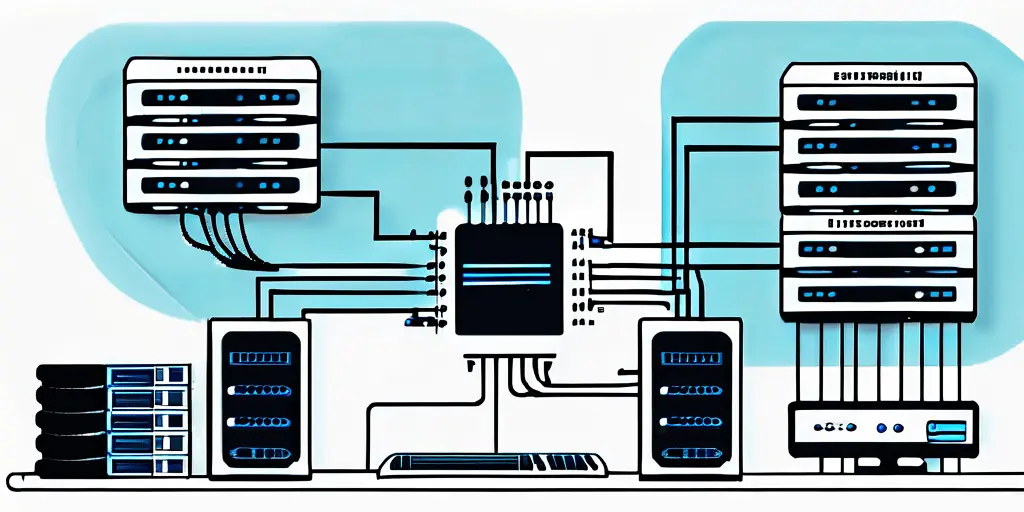The use of hypervisors has become increasingly prevalent in the field of virtualization, revolutionizing the way we manage and utilize computing resources. In this comprehensive guide, we will explore the fundamentals of hypervisors, their technical aspects, benefits, how to choose the right one, and future trends in the rapidly evolving realm of hypervisor technology.
Understanding the Basics of Hypervisors
Before delving into the technical aspects, it is crucial to grasp the fundamental concepts behind hypervisors. Simply put, a hypervisor is a software or hardware layer that enables multiple virtual machines (VMs) to run on a single physical computer simultaneously. It acts as a mediator between the VMs and the physical hardware, providing the necessary isolation and resource allocation.
Definition of a Hypervisor
A hypervisor, also known as a virtual machine monitor (VMM), is a software layer that allows for the creation and management of virtual machines. It abstracts the underlying hardware and provides each VM with its own isolated environment, complete with the necessary resources such as CPU, memory, and storage.
The Role of Hypervisors in Virtualization
Hypervisors play a crucial role in virtualization, as they enable the efficient utilization of physical hardware resources. They allow multiple operating systems to run concurrently on a single physical machine, thereby increasing resource efficiency and reducing costs.
Different Types of Hypervisors
There are two primary types of hypervisors: Type 1 and Type 2.
- Type 1 Hypervisors: Also known as bare-metal hypervisors, Type 1 hypervisors run directly on the physical hardware without the need for an underlying operating system. They provide excellent performance and scalability, making them ideal for enterprise-level virtualization deployments. Examples of Type 1 hypervisors include VMware ESXi and Microsoft Hyper-V.
- Type 2 Hypervisors: Type 2 hypervisors, on the other hand, run as software applications within an existing operating system. They are typically used for personal or small-scale virtualization needs and offer a simpler setup process. Popular Type 2 hypervisors include Oracle VirtualBox and VMware Workstation.
Now that we have covered the basics, let’s dive a bit deeper into the inner workings of hypervisors. One of the key features of hypervisors is their ability to provide hardware virtualization. This means that they create a virtual representation of the physical hardware, allowing each virtual machine to have its own virtual CPU, memory, and storage.
Additionally, hypervisors employ various techniques to ensure the isolation and security of each virtual machine. They use mechanisms such as memory protection, access control, and virtual networking to prevent one virtual machine from interfering with another. This level of isolation is crucial in multi-tenant environments, where multiple users or organizations share the same physical hardware.
Furthermore, hypervisors offer advanced management capabilities that allow administrators to efficiently allocate and manage resources across multiple virtual machines. They provide features like live migration, which enables the seamless movement of virtual machines from one physical host to another without any downtime. This flexibility and agility make hypervisors an essential component in modern data centers and cloud computing environments.
Delving into the Technical Aspects of Hypervisors
Now that we have laid the groundwork, let’s explore the technical aspects of hypervisors in more detail.

When delving into the technical aspects of hypervisors, it’s essential to understand the various types of hypervisors available in the market. There are two primary types of hypervisors: Type 1, also known as bare-metal hypervisors, run directly on the host’s hardware to control the hardware and to manage guest operating systems. Type 2 hypervisors, on the other hand, run on a conventional operating system just like other computer programs. Understanding the differences between these types can help in choosing the right hypervisor for specific use cases.
How Hypervisors Work
Hypervisors work by allocating physical resources such as CPU, memory, and storage to virtual machines. They manage the scheduling of resources, ensuring fair and efficient sharing among the VMs. Additionally, hypervisors provide virtual devices to virtual machines, allowing them to interact with external networks and storage systems.
Moreover, hypervisors employ various techniques to optimize resource allocation and utilization. Techniques such as memory ballooning, where the hypervisor can reclaim memory from one virtual machine and allocate it to another, help in improving overall system performance and efficiency.
The Architecture of Hypervisors
The architecture of a hypervisor can vary depending on the type and implementation. However, most hypervisors consist of two main components: the control domain and the guest domains. The control domain, also known as the hypervisor itself, manages the overall operation of the virtualized environment. The guest domains, on the other hand, are individual virtual machines running on top of the hypervisor.
Within the control domain, there are further components such as the virtual machine monitor (VMM) responsible for handling the execution of guest operating systems. Understanding this architecture is crucial for system administrators and developers working with virtualization technologies.
Hypervisor’s Interaction with Hardware and Software
Hypervisors interact with both the physical hardware and the software layers above them. They communicate with the hardware through device drivers and utilize virtualization technologies, such as Intel VT-x and AMD-V, to enable efficient virtualization. Furthermore, hypervisors interact with the guest operating systems, providing virtualized hardware interfaces and managing their execution.
It’s important to note that the advancements in hardware virtualization support have significantly improved the performance and scalability of hypervisors. Technologies like nested virtualization, where a hypervisor runs inside a virtual machine, have opened up new possibilities for running virtualized environments within virtualized environments.
Benefits of Using Hypervisors
Now that we have gained a deeper understanding of hypervisors, let’s explore the numerous benefits they offer.

Efficiency and Resource Management
Hypervisors enable the efficient utilization of physical hardware resources by allowing multiple virtual machines to run on a single physical machine. This not only reduces costs but also maximizes resource efficiency, making it possible to achieve higher levels of consolidation.
Moreover, hypervisors play a crucial role in dynamic resource allocation. They can allocate resources on-demand, ensuring that each virtual machine receives the necessary resources when needed. This dynamic resource allocation enhances overall system performance and prevents resource wastage, leading to a more streamlined and optimized computing environment.
Flexibility and Scalability
With hypervisors, it becomes effortless to scale up or down the virtualized infrastructure based on the changing needs of an organization. Adding or removing virtual machines can be done with ease, allowing businesses to adapt quickly to market demands and handle fluctuating workloads effectively.
Furthermore, the scalability offered by hypervisors extends beyond just adding or removing virtual machines. It also includes the ability to adjust computing resources such as CPU, memory, and storage dynamically. This flexibility ensures that organizations can respond promptly to changing business requirements without incurring significant downtime or disruptions.
Isolation and Security
Hypervisors provide strong isolation between virtual machines, ensuring that any issues or vulnerabilities in one VM do not affect others. This isolation enhances security and minimizes the risk of unauthorized access or data breaches. Additionally, hypervisors often offer advanced security features, such as encryption and secure VM migration.
Moreover, the isolation capabilities of hypervisors extend to network segmentation, where virtual networks can be created to isolate different sets of virtual machines. This network isolation adds an extra layer of security, preventing unauthorized access to sensitive data and enhancing overall network security posture.
Choosing the Right Hypervisor
When it comes to selecting a hypervisor for your virtualization needs, several factors should be taken into consideration.
Virtualization technology has revolutionized the way businesses manage their IT infrastructure. Hypervisors play a crucial role in creating and managing virtual machines, enabling organizations to optimize resources and improve efficiency.
Factors to Consider
Some key factors to consider include the required level of performance, scalability, management capabilities, compatibility with existing infrastructure, and cost. It is essential to evaluate your specific requirements and goals to choose the hypervisor that best aligns with your organization’s needs.
Performance is a critical aspect to consider when selecting a hypervisor. The ability to efficiently allocate resources, handle workloads, and deliver consistent performance is vital for the smooth operation of virtualized environments. Scalability is another key factor, as the hypervisor should be able to grow with your organization’s needs and support an increasing number of virtual machines.
Popular Hypervisor Solutions in the Market
There are several popular hypervisor solutions available in the market. VMware ESXi, Microsoft Hyper-V, and KVM are among the leading Type 1 hypervisors, offering robust features, performance, and extensive support. For Type 2 hypervisors, Oracle VirtualBox and VMware Workstation are widely used due to their ease of use and flexibility.
VMware ESXi is known for its reliability and advanced features, making it a preferred choice for enterprise environments. Microsoft Hyper-V, with its integration with Windows Server, provides seamless management and support for Windows-based workloads. KVM, as an open-source hypervisor, offers cost-effective virtualization solutions with strong performance capabilities.
Future Trends in Hypervisor Technology
As technology continues to evolve, so does the realm of hypervisors. Let’s explore some future trends that are shaping the future of hypervisor technology.

One of the most significant trends in hypervisor technology is its integration with cloud computing. Hypervisors are an integral part of cloud computing infrastructure, enabling the efficient allocation and management of resources in virtualized environments. As cloud computing continues to gain momentum, hypervisors will play a vital role in further optimizing cloud-based services and enhancing scalability.
Another emerging trend is the use of hypervisors in edge computing. With the rise of edge computing, the demand for hypervisors that can operate in resource-constrained environments is increasing. Hypervisors tailored for edge computing can streamline the deployment and management of virtualized services at the edge, allowing for more efficient processing and reduced latency. This opens up new possibilities for applications such as real-time analytics, IoT, and autonomous vehicles.
Furthermore, security enhancements in hypervisor technology are becoming a top priority. As cyber threats become more sophisticated, hypervisor vendors are investing in enhancing security measures to protect the virtualized environment. Advanced security features, such as secure boot and memory encryption, are being integrated into hypervisors to mitigate the risks posed by potential attacks. This ensures the integrity and confidentiality of data, providing organizations with peace of mind.
In conclusion, hypervisors facilitate the efficient utilization of computing resources through virtualization. With their ability to enable multiple virtual machines to run on a single physical machine, hypervisors offer benefits such as efficiency, flexibility, and security. Choosing the right hypervisor depends on various factors, and popular solutions like VMware ESXi and Microsoft Hyper-V dominate the market.
Looking ahead, hypervisor technology will continue to evolve, playing a crucial role in cloud computing, edge computing, and advancing security measures. Embracing the power of hypervisors can undoubtedly unlock significant potential for organizations across industries. By staying at the forefront of these future trends, businesses can harness the full capabilities of hypervisor technology and stay ahead in the ever-evolving digital landscape.
As you navigate the complexities of hypervisor technology and its implications for your organization’s cybersecurity, remember that the right expertise can make all the difference. Blue Goat Cyber, a Veteran-Owned business, specializes in a range of B2B cybersecurity services tailored to your needs, including medical device cybersecurity, penetration testing, and compliance with standards like HIPAA, FDA, SOC 2, and PCI. We are dedicated to fortifying your virtualized environments against the latest threats. Contact us today for cybersecurity help and partner with a team that’s as committed to your security as you are.
